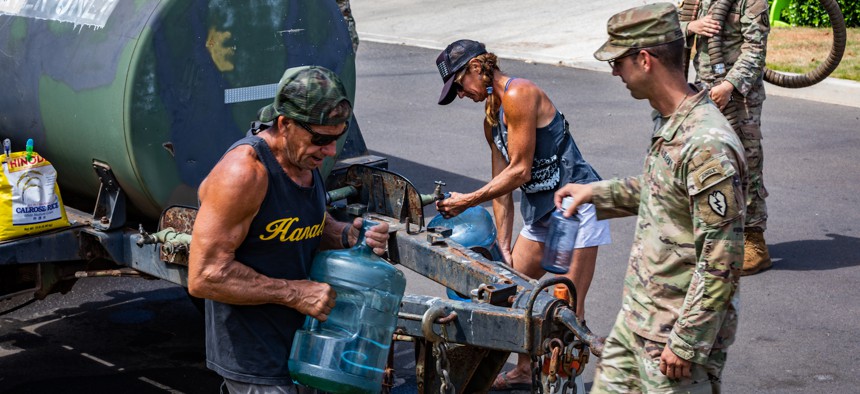
Soldiers from 225th Brigade Support Battalion, 2nd Infantry Brigade Combat Team, 25th Infantry Division and members of Joint Task Force 5-0 distribute water to residents of Lahaina, Maui, Aug. 30, 2023. U.S. Army / Staff Sgt. Matthew A. Foster
Maui relief efforts continue, with plans to begin debris removal in November
Nearly 700 defense personnel are helping in the wake of the deadly August wildfires.
More than 670 troops and Defense Department civilians are still “actively engaged” in the response to the devastating wildfires in Maui—continuing the search for victims while also clearing hazardous materials from the impact zone and preparing to allow residents and business owners to return to Lahaina.
“We’re working very closely with the county of Maui for the reentry phase of the operation,” Army National Guard Brig. Gen. Stephen Logan, the commander of Joint Task Force 5-0, told Defense One in an interview.
Efforts to find and recover bodies are continuing, as is an Environmental Protection Agency-led effort to find and remove hazardous materials from the burned area, Logan said: anything “from propane tanks to gasoline to asbestos to paints and thinners.”
Right now, 275 soldiers and airmen are manning checkpoints around Lahaina to keep people out of the area, but that is a “very dynamic” mission, and the checkpoints will collapse or move as the area is reopened, he said.
Some of the U.S. military’s missions in Maui have ended. Navy divers returned to Pearl Harbor after completing a survey and search of Lahaina Harbor, Schofield Barracks is no longer being used as a support facility, and the 25th Infantry Division’s fuel distribution operations are over.
But water distribution—which began in late August—continues, and the DOD teams have distributed 4,174 gallons of water in the Lahaina area since Aug. 25, a Pentagon spokesman told Defense One. Civilians from the Defense POW-MIA Accounting Agency as well as mortuary affairs personnel from Dover Air Force Base in Delaware are assisting with search for missing people. And the Army Corps of Engineers has teams on Maui working to establish a long-term forward command-and-control center for the debris-removal mission, which is to begin on November 1, as well as working with local officials to design a temporary school in the area.
Logan was appointed to lead the joint task force that coordinates Pentagon assistance for the relief efforts just days after wildfires ripped through the town of Lahaina, killing more than 100 people and displacing thousands more. His deputy, Col. David Fielder, was working on typhoon relief efforts in Guam at the time and rushed back to Hawaii to help, Logan said.
“We flew up there [to Maui] on a Blackhawk and we met with the mayor, and I laid out almost like a menu, what it was that [the U.S. military] had available,” Logan said. “His priorities were really security of the impact zone, because he had had people penetrate the zone and kind of step all over some of the areas that hadn’t been cleared yet. So they closed down the major bypass road that goes by the town of Lahaina,” while the military “focused on getting enough of a security team up here to augment the Maui Police Department, along with some other state law enforcement agencies, to kind of clear that up so he can open up [the bypass road] much quicker.”
Army Maj. Gen. Kenneth Hara, who commands the Hawaii National Guard, the Hawaii Emergency Management Agency, and the state’s office of homeland security, recently said that military leaders in Hawaii, including the head of U.S. Indo-Pacific Command, Adm. John Aquilino, and the commander of U.S. Army Pacific, Gen. Charles Flynn, “called me from Day One and said, ‘Whatever you need, whatever you request, the entire Department of Defense and especially all of the capabilities and resources within U.S. INDOPACOM would be there to support the state of Hawaii and the county of Maui.”
Logan has heard the criticisms of the military’s response to the disaster, and while he and other officials have made clear that all Pentagon support must be requested through Maui County, he also noted that responding to a catastrophic fire is not the same as responding to a typhoon.
“From people external from the state of Hawaii…they would say, ‘Hey, I think they need, like, a hospital ship offshore,” Logan said. “Not understanding that, unfortunately, because of the quickness of the wildfire, it did not seem like the existing medical organizations, like the hospitals and stuff like that, were inundated with patients. I think it rapidly transitioned to that fatality search and rescue operation, and I don’t think everybody had a clear understanding of that.”
“There were probably some folks that felt that the DOD was either slow or was not responsive enough, and I can tell you from personal experience, nothing could be further from the truth,” he said. “We’re listening to the people of Maui, because nobody can really tell us better what they need than they themselves.”
NEXT STORY: Marines to appoint a safety general





